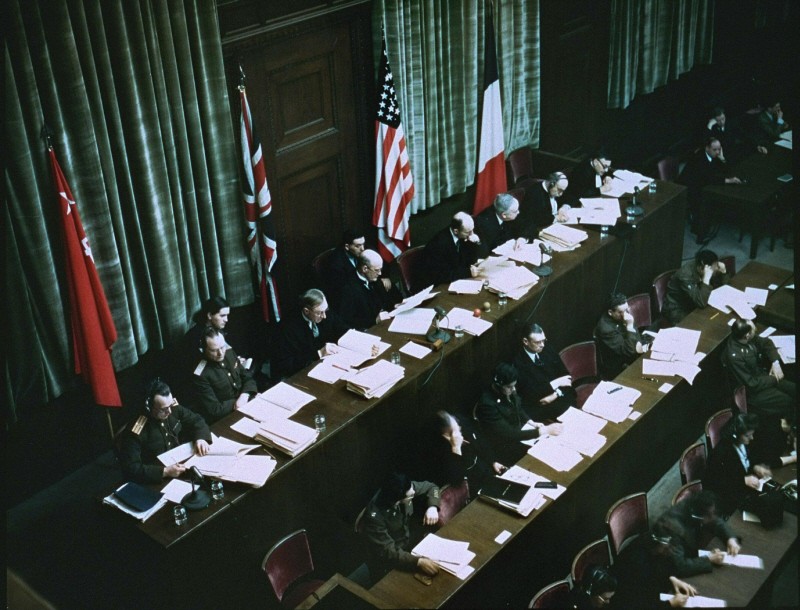
1945: Key Dates
January 12
Soviet forces launch a massive offensive from bases on the Vistula and Nida Rivers in central Poland. The offensive clears Polish soil of German troops and brings Soviet forces to the Oder River in Germany, at one point less than 100 miles from Berlin.
January 17
As Soviet troops approach, SS units begin the final evacuation of prisoners from the Auschwitz camp complex, marching them on foot toward the interior of the German Reich. These forced evacuations come to be called “death marches.”
January 25
The SS begins the final evacuation of the Stutthof concentration camp.
January 27
Soviet troops liberate Auschwitz, finding approximately 7,000 prisoners left behind in the main camp and its subcamps.
February 13
The 70th motorized infantry brigade of the Soviet Army liberates Gross-Rosen concentration camp.
Soviet troops accept the surrender of the last German and Hungarian units fighting in encircled Budapest, Hungary.
March 7
US troops cross the Rhine River at Remagen, Germany, leaving no more natural barriers blocking the advance into central Germany.
April 4
The 4th Armored Division and the 89th Infantry of the Third US Army liberate Ohrdruf, a subcamp of Buchenwald. After visiting Ohrdruf a week later, General Dwight D. Eisenhower orders careful documentation of the atrocities perpetrated in the Nazi concentration camps, so that no one in the future could deny that they had committed these atrocities.
April 11
Troops of the US 3rd Armored Division and 104th Infantry Division liberate the Dora-Mittelbau concentration camp in Nordhausen, Germany. They find few living prisoners left in the camp.
The US 4th Armored Division and the 80th Infantry Division liberate more than 21,000 prisoners at Buchenwald.
April 12
Canadian forces liberate around 880 prisoners at the Westerbork camp in the Netherlands.
April 15
The 63rd Anti-tank Regiment and the 11th Armoured Division of the British army liberate about 55,000 prisoners at the Bergen-Belsen concentration camp.
April 20
As British troops advance, the Gestapo hangs 20 Jewish children, who had been exploited for medical experiments, in a basement of the Bullenhuser Damm School in Hamburg, Germany.
April 20–22
The SS evacuates prisoners from the Sachsenhausen concentration camp by forced marches. On April 22, units of the First and 47th Polish Armies liberate about 3,000 inmates remaining in the camp.
April 21
Soviet troops encircle Berlin. One day earlier, Adolf Hitler had announced to his top leaders that he would remain in Berlin.
April 21–25
At Mauthausen, SS functionaries kill 1,441 sick inmates in the gas chambers.

April 23
The 90th US Infantry Division liberates the Flossenbürg concentration camp in Germany.
April 25
Soviet and American troops meet at Torgau, Germany.
April 28
SS functionaries murder 33 members of the Upper Austrian Socialist Party Communist Party organizations in the gas chamber at Mauthausen concentration camp—the last gassing operation in the Third Reich.
April 29
The 42nd and 45th Infantry Divisions and the 20th Armored Division of the US Army liberate approximately 32,000 prisoners at Dachau.
April 30
Hitler commits suicide in his bunker in Berlin.
Soviet troops liberate over 2,000 prisoners at Ravensbrück. In April, before Soviet troops reached the camp, SS authorities had murdered between 5,000 and 6,000 prisoners in the gas chamber at Ravensbrück.
Late April–early May
The partisan resistance movement, under Communist leader Josip Tito, liberates the Jasenovac concentration camp in Croatia.
May 2
German units in Berlin surrender to Soviet forces.
May 4
British forces liberate the Neuengamme concentration camp near Hamburg, Germany.
May 5
The US 11th Armored Division liberates prisoners at the Mauthausen and Gusen concentration camps in the annexed Austrian territory of the German Reich.
May 7–9
German armed forces surrender unconditionally in the West on May 7 and in the East on May 9. Allied forces proclaim May 8, 1945, to be Victory in Europe Day (V-E Day). Soviet forces proclaim May 9, 1945, as the day the war ended.
May 9
Soviet forces enter and liberate the camp-ghetto Theresienstadt.
Soviet forces liberate Stutthof concentration camp, near Danzig.
August
United States special envoy Earl Harrison makes a public report to President Truman on the treatment of Jewish displaced persons (DPs) in Germany. Following World War II, several hundred thousand Jewish survivors are unable or unwilling to return to their home countries. Harrison's report contains a strong indictment of Allied military policies, underscores the plight of Jewish DPs, and leads eventually to improved conditions for them in the US zone of occupied Germany.
September 2
Japan surrenders. World War II officially ends.

November 20
The International Military Tribunal (IMT), made up of US, British, French, and Soviet judges, begins a trial of 22 major Nazi leaders at Nuremberg, Germany.
December 22
US President Truman issues a directive giving preference to displaced persons for immigrant visas under existing US immigration quota restrictions.
Critical Thinking Questions
How did the Germans continue to persecute and murder Jews even though the war was nearing conclusion?
What challenges did survivors face in the DP camps?
What challenges did the Allies face in establishing and supervising DP camps?

